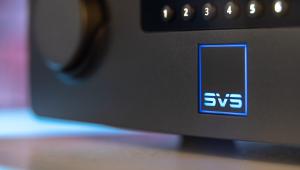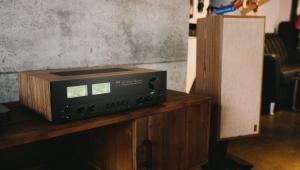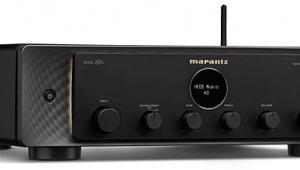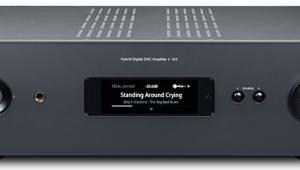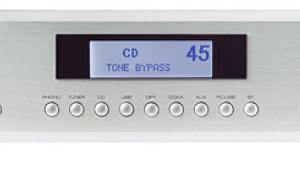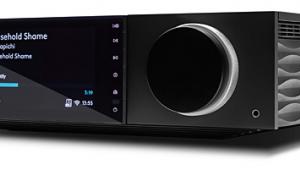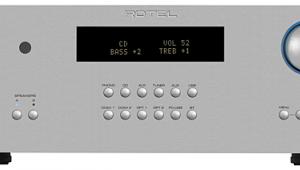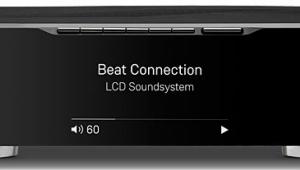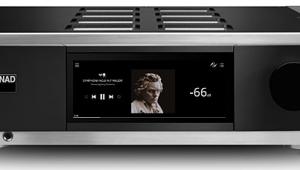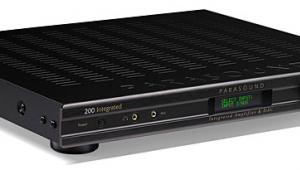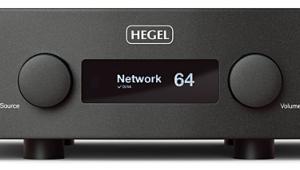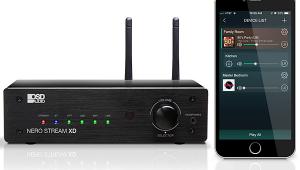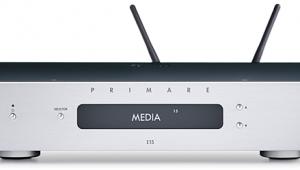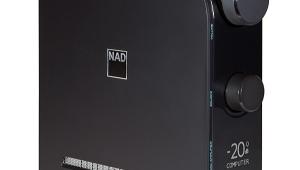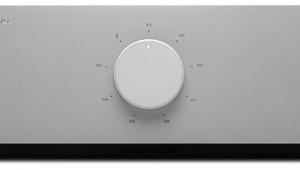NAD D 3045 Integrated DAC/Amplifier Review Page 2
The remaining three Bass settings are 120, 80, and 40 Hz high-pass filters meant for when one connects a subwoofer to the NAD's preamp/subwoofer line outs. I happened to have a suitable small, but quite capable, 8-inch sub lying around, so I slid it under the desk and this proved the hot setup. With the sub balanced well below localizable/booming level, the result was honestly full-range reproduction with strong, razor-sharp imaging. Bottom line: The D 3045 can definitely brew up serious desktop listening, but you must first do something to tame the 1-2 kHz suckout caused by the floor-bounce—er, desk-bounce—first reflection. (A double layer of bubble-pack covered by some fuzzy stuff worked quite well for me.)
 Of course, many, if not most, users will deploy NAD's latest in a big, or at least bigger, system, so I moved the D 3045 over to my main rack and connected it to my ancient but still excellent Energy Veritas 2.8 three-ways. These compact standmount monitors are very nearly full range despite their size. But as Villchur's Iron Law of Speaker Design (sensitivity, extension, or compactness: pick two) predicts, they pay no small price in sensitivity, being 3 or 4 dB less so than most modern speakers of similar ability. This laid out a fairly serious challenge for the NAD's nominal 60 watts per channel (my everyday power amp is 150 watts per channel), but the D 3045 proved up to it. I noted no loss in resolution or dynamic detail, and while I can't say that the NAD equaled my regular power amp's ultimate level and dynamics capability, the shortfall was very slight. At a guess I'd say it was much less than 3 dB, which suggests that the little D 3045 was delivering substantial dynamic power—a hallmark of NAD designs.
Of course, many, if not most, users will deploy NAD's latest in a big, or at least bigger, system, so I moved the D 3045 over to my main rack and connected it to my ancient but still excellent Energy Veritas 2.8 three-ways. These compact standmount monitors are very nearly full range despite their size. But as Villchur's Iron Law of Speaker Design (sensitivity, extension, or compactness: pick two) predicts, they pay no small price in sensitivity, being 3 or 4 dB less so than most modern speakers of similar ability. This laid out a fairly serious challenge for the NAD's nominal 60 watts per channel (my everyday power amp is 150 watts per channel), but the D 3045 proved up to it. I noted no loss in resolution or dynamic detail, and while I can't say that the NAD equaled my regular power amp's ultimate level and dynamics capability, the shortfall was very slight. At a guess I'd say it was much less than 3 dB, which suggests that the little D 3045 was delivering substantial dynamic power—a hallmark of NAD designs.
NAD calls the D 3045 a “hybrid digital” amplifier in its marketing materials, but I could find no elaboration on this sobriquet. It's likely that the D 3045 is a class-D design, or some variant thereof (a little Internet sleuthing suggested that it uses Hypex class-D modules), but whatever the topology, I found it a highly capable little power producer. All things being equal, more power is always better than less, but that said, in modest-sized rooms, with speakers of typical modern sensitivity (say, 88 dB SPL/1m or higher) the D 3045 should prove capable of serious playback at serious levels, meaning it's perfectly suitable as a “main” system amplifier even for discerning listeners.
The D 3045's headphone amp—an item likely to be of equal interest to potential owners among that same set—similarly passed muster. Not surprisingly, it sounded amply loud, decidedly extended, and impressively dynamic via a set of NAD Viso headphones, yet managed to avoid shrillness with my longterm (very) Sony MDR-V6 cans, a widely accepted, if on-the-bright-side, standard. Another checkmark: It had enough output to drive my HiFiMan Edition X planars to more-than satisfying levels without generating any flappiness or harshness.
There is inevitably little to report on the ergonomics front regarding a component with functions limited to volume adjustment and source selection. One annoyance I encountered was that after an idle period of some few minutes, the D 3045 would drop a USB connection with my iMac, requiring a power-cycle to return to duty (switching inputs away from, and back to, the NAD's “Computer” USB input would not do the trick). In fairness, I cannot say whether this fault lies with the amplifier's firmware, the computer's USB-out behavior, or somewhere in the murky depths of the Mac OS Audio/MIDI setup utility.
The D 3045's front-panel knobs feel fairly nice, and the little remote controller's even-dozen pushbuttons proved easy to learn. I wasn't crazy about NAD's touch-sensitive on/off “button,” which is really just an illuminated international slashed-circle power logo spot on its curvature. You need to hold a finger in place for a second or so to get a response, and in a bright room it's tough to see the logo illuminate. And when powering down, your finger obscures the logo, so how do you know when long enough is long enough for Off? (In actual use, the remote control's real hardware on/off buttons sidestep this quandary.)
Conclusion
If NAD's goals for the D 3045 included designing a DAC/amp that's simple yet versatile enough to span applications from the dorm room to the studio reference room, I think they have succeeded. Barely more complicated than a light switch, the NAD amp delivers the finely etched detail, dramatic dynamics, and jet-black background silences that characterize the best of hi-res audio in a package that's affordable enough to unite casual listeners and budget-sensitive audiophiles under a single tent.

